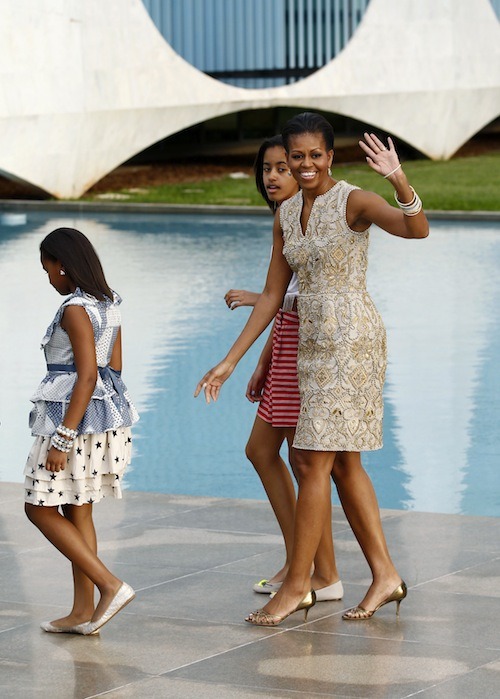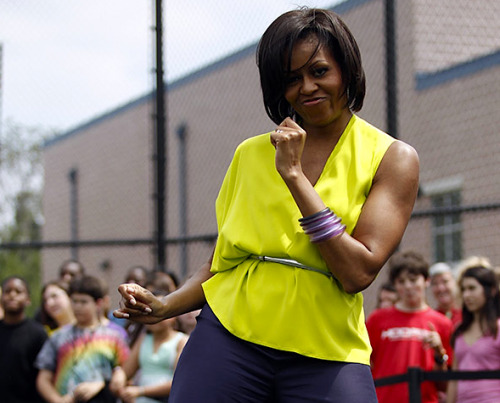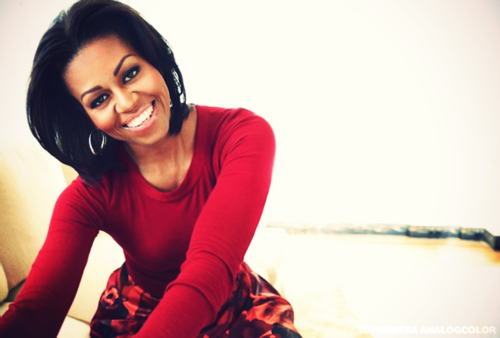Michelle Obama Taps into the Political Power of Style
During each woman’s four to eight years in the public eye, whether seen accompanying their husbands to various functions or carrying out their duties as official hostess of the white-house, some first-ladies develop somewhat of an aversion towards fashion. Their presence is often seen but seldom heard, giving them the unique opportunity to use fashion as a vehicle to drive their point across without actually saying anything. Instead of taking advantage of this pedestal, first-ladies since the days of the revered Jackie O, have veered towards the safe side of personal style. Dull and uninspiring in skirt-suits accessorized with single strands of pearls, they feared dressing otherwise would have take away from their credibility and commitment to serious causes.

There is an entire psychology behind the application of certain styles and specific colors as means to convey positive vibes to voters. It is a mechanism previously untapped in the political sphere that current first-lady Michelle Obama, 47, wants to explore. Mrs. Obama’s attentiveness to fashion does not make her any more politically inept than the first-ladies who came before her, in fact, her dedication to utilizing fashion as a form of communication further expands her voice of influence.
During the four years in which her husband, Barack Obama, has been president, she has helped lead the fight against childhood obesity by starting a foundation called “Let’s Move!”, a charitable cause that she wordlessly promotes through her devotion to athletic pieces and comfy basics. In 2009 she wore hiking shorts to disembark Air Force One. A bold choice on her part, the casualty of her look symbolized the relaxation of American policies. When she showed up to her first day in office dressed in a lemon-sherbet-colored shift dress by Isabel Toledo, Michelle expressed to the world her hopeful outlook for the term ahead.

Her influence on the fashion industry has been more of a ripple than a splash, but significant nonetheless. Whenever she dons J. Crew at a public appearance, the company’s stock prices appreciate in anticipation of the supplemental influx in sales. Her sartorial selections have put at least two previously unknown designers, Jason Wu and Thakoon Panichgul, on the map.
As part of her job description, Obama is to stay in touch with current affairs from around the world. She uses fashion to symbolize her connection with the American society at large. As the first-lady, she must consider the economy of the nation before getting dressed and remain sensitive to the fact that many citizens are living on a day-to-day income. Keeping this in mind, her daywear generally consists of affordable pieces (mostly by American designers) so that the average American woman may replicate her style. Unlike Obama, first-ladies in the past, most notably Jackie Kennedy, have attired themselves in upscale designer pieces. While the first-lady can certainly afford to do so, it is important to keep in mind the message that a three of four figure price tag can send to voters. By dressing in high-street contemporary brands like J. Crew, Target, and Gap, she proves to Americans that she is a relatable woman who knows how to shop on a budget.
That’s not to say that she doesn’t appreciate glamour on occasion. Michelle has had a few spellbinding moments in fashion that live up to her renowned position as a so-called style icon. Remember the jaw-dropping, one shouldered gown designed by Jason Wu that she wore to her husband’s inauguration ball? A trip to its current reside at the Smithsonian Institution in D.C. shows just how monumental it was when compared to past inaugural gowns of the stuffy, traditional variety.
Taking a page from Kennedy herself, Obama loves flattering her toned arms. While the eternally elegant Kennedy preferred to outfit her arms with a pair of long white gloves, a mainstay in the early ‘60s, Obama flaunts her athleticism in a vast array of sportswear, further inspiring children and families to get outside and exercise.
Women in politics generally follow the popular myth that one must dress in a masculine style in order to be taken seriously. Women’s fashion is too much of a risk to their career as flare can lead to controversy. Obama appeared on the scene at exactly the right time to help show women that prints and color can be just as appropriate in politics as in any other profession.
Whether she is dressing for the inaugural ceremony (Jason Wu), a White House dinner (Peter Soronen for her first), or meeting the Queen of England (Isabel Toledo and Jason Wu), she presents herself with class and poise. For a woman who “loves clothes,” and encourages all women to “wear what makes them happy and what makes them feel comfortable,” to be in her position, it provides female politicians an outlet to communicate with the general public through subconscious messages of a positive future.











